|
Chorale Melodies used in Bach's Vocal Works
Vater unser im Himmelreich
|
|
Melody & Text | Use of the CM by Bach | Use of the CM by other composers | Arrangements/Transcriptions | English Hymnals using the German CM |
| |
|
Melody & Text: Zahn: 2561 | EKG: 241: |
|
Melody Source: |
|
This chorale melody is probably based upon a melody from the Middle Ages, not necessarily sacred in nature, and appeared in print for the first time in “Geistliche lieder” edited and published by Valentin Schumann [Leipzig, 1539] where it is connected with the present text.
Martin Luther’s first draft for the text of Vater unser im Himmelreich includes a melody which Luther subsequently rejected (the notes he sketched near the end of the verses of this chorale text are crossed out by him.): |
|
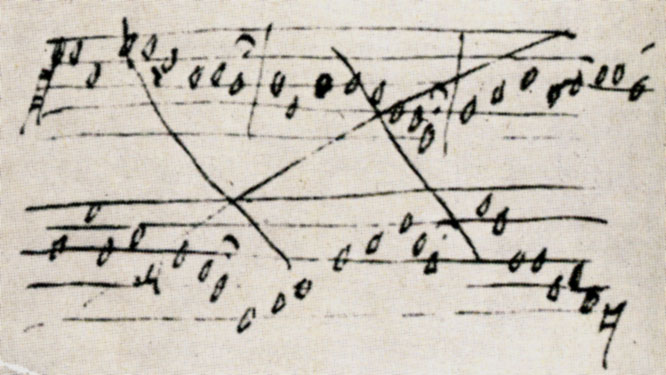
|
|
It is likely, but not clearly documented, that Luther then had a hand, possibly in collaboration with Johann Walter or another contemporary musician/composer, in choosing the present melody with which the words have always remained connected. It is not an original melody by Luther, but Luther is known for his ability to select good melodies, sacred as well as secular, for his chorale texts. |
| |
|
Possible sources used by Bach: |
|
Unspecified mid 17th century source 1: |
|
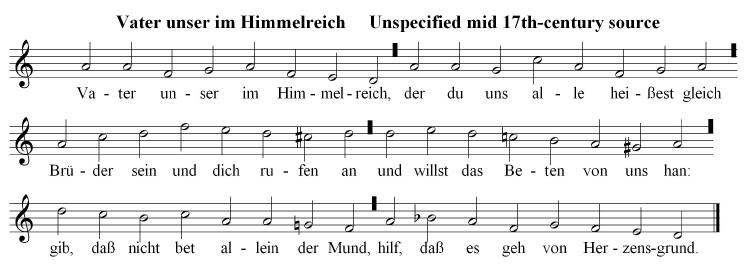
|
|
Unspecified mid 17th century source 2: |
|

|
|
Vopelius (1682): |
|

|
|
Gotha Hymnal (1715): |
|

|
| |
|
Text : Vater unser im Himmelreich | EKG: 241 |
|
This is Martin Luther’s transformation into verse form of the Lord’s Prayer (Luke 11: 2-4). Some excellent information about this particular chorale as well as Luther’s role and influence generally upon chorale texts and melodies is contained in several articles in the MGG1 [Bärenreiter, 1986] written by Konrad Ameln and Walter Blankenburg. Here are some pertinent excerpts: |
|
>> Nach der Württemberger Kirchenordnung von 1536 konnten an Festtagen an Stelle von ein bis zwei Psalm-Liedern vor der Predigt Leisen wie »Gelobet seist du, Jesu Christ«, »Christ ist erstanden« usw. und nach der Predigt, ebenfalls ersatzweise, Luthers Glaubenslied gesungen werden. Im eigentlichen Abendmahlsteil erschien das Vater unser als Gemeindegesang (wohl zumeist Luthers »Vater unser im Himmelreich«, das in Mittel- und Norddeutschland zunächst lehrhaftes Katechismuslied war und später Graduallied für den Sonntag Rogate wurde), während die sub communione-Gesänge dieselben wie im Wittenberger Gebiet waren.<<
[“According to the Württemberg Order of Church Services from 1536, it was permissible on church holidays to sing before the sermon as a replacement for the usual one or two Psalm chorales, “Leisen” {refrain-like, sung responses by the congregation} like “Gelobet seist du, Jesu Christ,” “Christ ist erstanden,” etc., while after the sermon Luther’s Credo could also be sung as a replacement {for Psalm chorales.} In the communion portion of the main church service, the “Our Father” was sung by the congregation, most often in the form of Luther’s “Vater unser im Himmelreich”, which at first was treated in Middle and North Germany as an instructive catechism chorale and only later assumed its position as a chorale associated with the Epistle for the Sunday Rogate, while other chorales sung during communion were the same as those in the Wittenberg region”]
>> Luthers überragende Bedeutung für das Kirchenlied beruht darin, daß er nicht nur Theologe und Dichter, sondern auch in hohem Maße musikalisch gebildet war; seine Kirchenlieder sind selbst dann wie aus einem Guß, wenn er ältere Texte übernimmt und weiterdichtet oder ältere Weisen, teils unverändert, teils umgeformt, verwendet. Während er in einigen Fällen sehr behutsam vorgeht, scheut er bei den meisten Vorlagen nicht vor kräftigen Eingriffen zurück. Auch bei der Übertragung der Texte hält er sich manchmal sehr genau an den Wortlaut; »Verleih uns Frieden gnädiglich« ist z.B. eine ziemlich wörtliche Übersetzung der Antiphon »Da pacem Domine«. In anderen Fällen gestaltet er mit größter Freiheit neu; so ist z.B. sein Lied »Vater unser im Himmelreich« eine weit ausholende Paraphrase des Vaterunsers.<<
[“ Luther’s outstanding significance for chorales is based upon the fact that he was not only a theologian and poet, but also musically educated to a high degree; his chorales are completely rounded (as if made in one cast) even when he takes older, existing texts and extends them or makes use of older melodies leaving them partially as they were and partially changing the form of the melody. While he may in several instances move ahead very cautiously, in most instances he does not restrain himself from making major changes as necessary where previous, existing sources are being used. Also, in rendering existing texts, he remains very true to the original wording: “Verleih uns Frieden gnädiglich” is, for example, a rather literal translation of the antiphon “Da pacem Domine.” In other cases he reforms/reshapes the text allowing himself the greatest freedom possible For example, his chorale “Vater unser im Himmelreich” is an expansive, far-reaching paraphrase of the Lord’s Prayer.”]
>>Das Ergebnis der umfangreichen, über einen großen Zeitraum sich erstreckenden Forschungen über Entstehung und Stil der einzelnen Weisen seiner Lieder kann heute in folgenden Punkten zusammengefaßt werden:
1. Grundsätzlich hat Luther nach Meistersingerart im Hinblick auf die gottesdienstliche Zweckbestimmung seiner Dichtungen auch die Aufgabe der Beschaffung der erforderlichen Weisen mit übernommen.
2. Melodiebeschaffung bedeutete im 16 Jahrhundert nicht Neuerfindung von Weisen, sondern Bearbeitung von Vorlagen.
3. Luthers außerordentliche Meisterschaft hat sich in dem Maß von deren künstlerischer Neugestaltung erwiesen.
4. In einzelnen Fällen darf die Mitwirkung seiner musikalischen Mitarbeiter, vor allem J. Walters, angenommen werden, ohne daß Einzelentscheidungen mit absoluter Sicherheit möglich wären. Auch der nach R. Gerber einem Personalstil Luthers gleichkommende, auf Meistersang-Elementen beruhende jonische Melodietypus (»Vom Himmel hoch«, »Ein feste Burg«, »Ein neues Lied wir heben an« und die ursprüngliche, vom Reformator aber selbst wieder verworfene Fassung von »Vater unser im Himmelreich« begegnet bei Weisen zu Liedern anderer Dichter (vgl. J. Walters Weise zu «Vom Himmel hoch»).
5. Die Wittenberger Weisen zu Luthers Liedern sind neben accentus-Gestaltung durch Wortbezogenheit des Melodieverlaufs gekennzeichnet (vgl. K. Ameln über die aufschlußreiche Ableitung von drei Weisen aus der Hymnus-Melodie «Veni redemptor gentium»). Je nach Herkunft der Vorlagen sind sie teils kirchentonal und teils volkstümlich jonisch. Ihre rhythmische Grundstruktur ist isometrisch mit entweder verlängerten (gewöhnlich bei Gebetstexten) oder umgekehrt verkürzten Zeilenanfangsnoten (gewöhnlich bei reinen Aussagetexten). Vereinzelte polymetrische Melodiefassungen erklären sich aus deren Überlieferung als Lied-tenores.
6. Als musikalische Vorlagen dienten Hymnenmelodien, mittelalterliche liturgische Gesänge verschiedener Art, Leisen, spätmittelalterliche geistliche sowie (vereinzelt) weltliche Volkslied-Weisen.<<
[“The results of the extensive research that has taken place over a long period and has covered the origin and style of each of Luther’s chomelodies can currently be summarized to include the following points:
1. Following basically the method of the Meistersingers, Luther, having in mind that the purpose/destination of his chorale verses would be for use during the church services, also adopted their method of obtaining the necessary melodies for these verses.
2. Obtaining melodies in the 16th century did not mean creating new ones, but rather adapting and revising already existing ones.
3. Luther’s extraordinary mastery is proven by the degree of artistic renovation/reshaping of already existing materials.
4. In some instances it can be presumed that Luther collaborated with musicians, particularly with Johann Walter, without, however, making it possible to determine very definitely who was responsible for making certain decisions. Even the special type of melody, which according to R. Gerber, comes close to being a very personal style of melody based upon an Ionian melody type coming from Meistersinger elements (examples are: “Vom Himmel hoch,” “Ein feste Burg,” “Ein neues Lied wir heben an,” and the original version of “Vater unser im Himmelreich” [See: Rejected melody] which Luther himself later rejected, are also found in the melodies used for chorale texts by other poets (cf. Johann Walter’s melody for “Vom Himmel hoch” [this is not the same one that Bach knew and is still currently in use.]
5. In addition to taking into account the accent placement, Luther’s ‘Wittenberg’ melodies are distinguished by means of their relationship to the specific words of the text. (Compare Konrad Ameln’s revealing study in which he derives three separate melodies from the hymn melody “Veni redemptor gentium.”) Depending upon the origin of the source melodies, they tend to be partly in church modes and partly of an Ionian ‘folksong’ type. Their basic structure is isometric, having either long notes at the beginning of a line (usually these are prayer texts) or the opposite: short notes (usually when the texts are purely statements.) Occasional polymetric melody versions can be explained by the fact that they derive from tenor cantus firmus songs.
6. For musical materials upon which to base his melodies, Luther used older hymn melodies, various liturgical song forms from the Middle Ages: “Leisen” {“refrain-like responses by the congregation}, but also various spiritual/sacred as well as (only occasional instances) secular folksongs from the Late Middle Ages.”]
|
| |
|
1st Alternate Text: EKG: 119 “Nimm von uns, Herr, du treuer Gott” (1584) |
|
By Martin Moller (1547-1606)
Moller was born in Kropstädt near Wittenberg. Although poverty prevented him from obtaining the necessary preparation at a university, Moller, after serving a short time as Kantor, soon became a pastor in Löwenberg in 1569, and later assumed the same position in several other Silesian churches and finally became the main pastor at the St. Peter & Paul Church in Görlitz. He wrote and had published various devotional treatises, in part building upon older sources (St. Augustine, etc.) He became blind at the end of his life and died in 1606.
This chorale text, along with 3 others, still appears in the current German (Evangelical-Lutheran) hymnal and it still is associated with the melody for “Vater unser im Himmelreich.” |
| |
|
2nd Alternate Text: So wahr ich lebe, spricht dein Gott | EKG: 169 (1630) |
|
By Johann Heermann (1585-1647).
Heermann was a poet laureate and is considered the most important chorale text writer between Martin Luther and Paul Gerhardt. The present German (Evangelical-Lutheran) hymnal contains 14 chorale texts by Heermann. This text is still associated with the above melody for “Vater unser im Himmelreich.” |
| |
|
Use of the Chorale Melody by Bach: |
|
Text 1: Vater unser im Himmelreich | EKG: 241
Author: Martin Luther |
|
Ver |
Work |
Mvt. |
Year |
Br |
RE |
KE |
Di |
BC |
Score |
Music Examples |
|
4 |
BWV 245 |
Mvt. 5 |
1724 |
47 |
317 |
- |
137 |
D2:5 |
PDF |
Mvt. 5 (MG) [midi] |
|
BWV 416: (Breitkopf 47, Dietel 137 is simply an older version of the same harmonization as the later BWV 245/5. The NBA lists this situation as follows:Breitkopf 47 = BWV 416 vel 245/5 (ältere Fassung) |
|
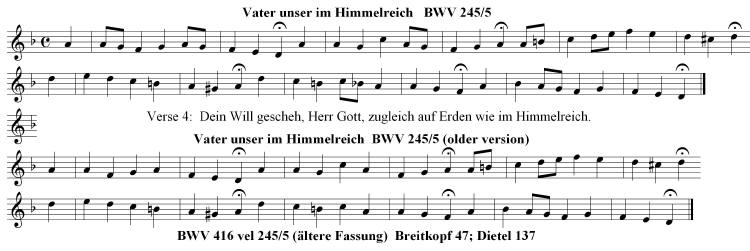
|
| |
|
Text 2: Nimm von uns, Herr, du treuer Gott | EKG: 119 |
|
Ver |
Work |
Mvt. |
Year |
Br |
RE |
KE |
Di |
BC |
Score |
Music Examples |
|
7 |
BWV 90 |
Mvt. 5 |
1723 |
267 |
319 |
267 |
41 |
A163:5 |
PDF |
Mvt. 5 (MG) [midi] | Mvt. 5 (Leusink) [ram] |
|
1 |
BWV 101 |
Mvt. 1 |
1724 |
- |
- |
- |
- |
A118:1 |
- |
Mvt. 1 (Leusink) [ram] |
|
3 |
BWV 101 |
Mvt. 3 |
1724 |
- |
- |
- |
- |
A118:3 |
- |
Mvt. 3 (Leusink) [ram] |
|
4~ |
BWV 101 |
Mvt. 4 |
1724 |
- |
- |
- |
- |
A118:4 |
- |
Mvt. 4 (Leusink) [ram] |
|
5 |
BWV 101 |
Mvt. 5 |
1724 |
- |
- |
- |
- |
A118:5 |
- |
Mvt. 5 (Leusink) [ram] |
|
6~ |
BWV 101 |
Mvt. 6 |
1724 |
- |
- |
- |
- |
A118:6 |
- |
Mvt. 6 (Leusink) [ram] |
|
7 |
BWV 101 |
Mvt. 7 |
1724 |
- |
318 |
192 |
73 |
A118:7 |
PDF | PDF v |
Mvt. 7 (MG) | Mvt. 7 (MG) ver [midi] | Mvt. 7 (Leusink) [ram] |
|

|
|

|
|

|
|
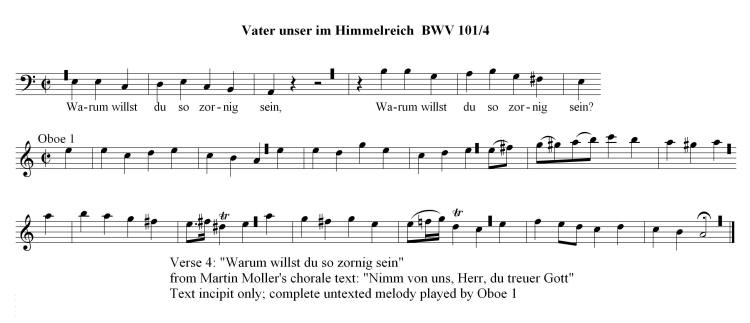
|
|
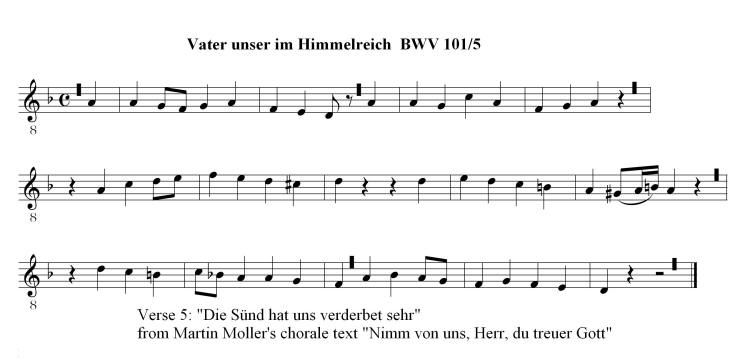
|
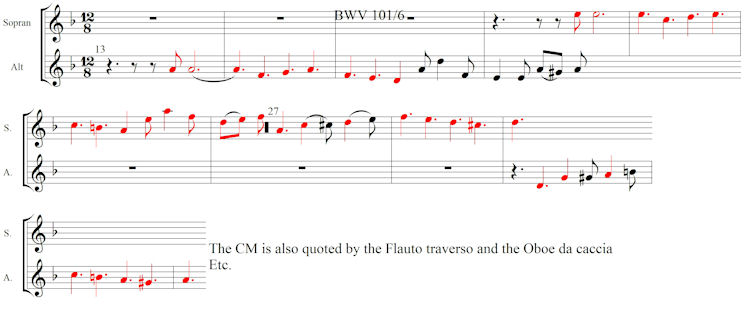 |
|

|
| |
|
Text 3: So wahr ich lebe, spricht dein Gott | EKG: 169
Author: Johann Heermann (1630) |
|
Ver |
Work |
Mvt. |
Year |
Br |
RE |
KE |
Di |
BC |
Score |
Music Examples |
|
6 & 7 |
BWV 102 |
Mvt. 7 |
1726 |
110 |
320 |
110 |
|
A119.7 |
PDF |
Mvt. 7 (MG) [midi] | Mvt. 7 (Leusink) [ram] |
|

|
| |
|
Untexted: |
|
Ver |
Work |
Mvt. |
Year |
Br |
RE |
KE |
Di |
BC |
Score |
Music Examples |
|
- |
BWV 416 |
- |
? |
47 |
316 |
47 |
137 |
F181.4a |
Score | PDF |
Chorale (MG) [midi] |
|
- |
BWV 636 |
- |
1713/15 |
- |
- |
- |
- |
K65 |
- |
|
|
- |
BWV 682 |
- |
1739 |
- |
- |
- |
- |
K14 |
- |
|
|
- |
BWV 683 |
- |
1739 |
- |
- |
- |
- |
K15 |
- |
|
|
- |
BWV 737 |
- |
1717 |
- |
- |
- |
- |
K112 |
- |
|
|
BWV 762: of doubtful authenticity; has not been accepted by the NBA
BWV 760 and BWV 761: were not composed by J.S. Bach. See under Georg Böhm. |
| |
|

|
|
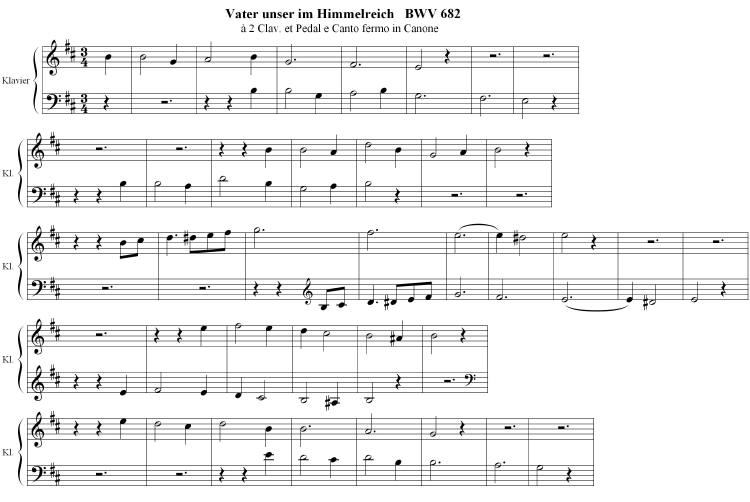
|
|

|
|

|
|

|
| |
|
Use of the Chorale Melody by other composers: |
|
Johann Weinmann (1477-1542):
Vater unser im Himmelreich, Setting for 4 voices (This work was published posthumously in 1544) |
|

|
|
Benedictus Ducis (c 1492-1544):
Vater unser im Himmelreich, 4vv (1544) |
|
Johann Stahl (2nd quarter of the 16th century):
Vater unser im Himmelreich Setting for 4 voices |
|
Jörgen Presten (?? - 1553):
Vater unser im Himmelreich 6st |
|
Richard Edwards (1525-1566):
Vater unser im Himmelreich Melody was used by him: |
|
>>There is a setting of the Lord’s Prayer by Edwards in Day’s Psalter of 1563; the tune is the ‘Vater unser’, melody later used by Bach (first printed in Valentin Schumann’s Geistliche Lieder, 1539; first English printing in Psalmes of David, 1560).<<
Michael Smith (Grove Music Online, Oxford University Press, 2005, acc. 10/4/05
|
|
Ivo de Vento (died 1575):
Vater unser im Himmelreich Setting for 3 Voices |
|
Orlando di Lasso (c1532-1594):
Vater unser im Himmelreich (Luther), 5vv (1567c); S xviii, 1 |
|
Philipp Avenarius [German family name ‘Habermann’] (born c 1553, no date of death)
Vater unser im Himmelreich A Setting for 5 Voices |
|
Christoph Praetorius
(died 1609) was an uncle of Michael Praetorius
Vater unser im Himmelreich, Chorale Motet for 4 voices (Wittenberg, 1541) |
|
Hans Leo Hassler (1564-1612):
Vater Unser Im Himmelreich, chorale for chorus (from Psalmen und Christliche Gesänge) (1607) |
|
Michael Praetorius (c 1571-1621):
Vater unser im Himmelreich, for organ
Vater unser im Himmelreich, for double-choir from "Urania" (1613) Nr. X |
|
Martin Zeuner (1554-1619):
Vater unser im Himmelreich Setting for 5 voices appearing in “82 Schöne Geistl. Psalmen, nach dem Choral oder Thon 5stimmg, Nürnberg 1616” |
|
Nicolas Vallet (c1583-c1615):
Onse Vader in Hemelryck, a set of variations on Vater unser im Himmelreich, in Secret des Muses book II (1616)
See: , a set of variations on Vater unser im Himmelreich, in Secret des Muses book II (1616)
See: Secret des Muses (Vallet, Nicolas) (IMSLP), page 48-50, or in the PDF file on 52-54
Contributed by Jelle Kalsbeek (August 18, 2015) |
|
Johann Hermann Schein: (1586-1630):
Vater unser im Himmelreich, cantata for 2 soprano voices & continuo (Opella nova, Part 1, No. 12) (1618); A iv, 60, P v, 52
Vater unser der du bist im Himmel, cantata for 2 voices, 5 voices, instruments & continuo (Opella nova, Part 2, No. 18) (1618);
Vater unser im Himmelreich, hymn for 4 voices (& continuo) (Cantional...) (1627); A ii/1, 86 |
|
Jacob Praetorius (1586-1651):
Vater unser im Himmelreich, Chorale Prelude for Organ |
|
Samuel Scheidt (1587-1654):
Vater unser im Himmelreich 3 Canons and a Chorale Prelude for Keyboard SSWV 104, 115, 121, 126
Vater unser im Himmelreich, 4-pt Setting from the Tabulatur=Buch, SSWV 471 (Görlitz, 1650)
Vater unser im Himmelreich (chorale), 8vv; SSWV 32 S iv, 144 |
|

|
|
>>The style of Scheidt’s motets is a lively mixture of traditional German elements, the Dutch influence of his teacher Jan Pieterszoon Sweelinck (whose own Cantiones sacrae had appeared in 1619), and the Italian concerto style as mediated by Michael Praetorius, with whom he had worked in 1616 and 1618. Nearly half of the collection is devoted to settings of German chorales. These are typically restricted to one stanza, beginning with two motet-style expositions of the first phrase, one for each choir, and proceeding to a much closer interchange between choirs, often echoing very short motifs. Two settings per omnes versus (Christe, der du bist Tag und Licht and Vater unser im Himmelreich) are similar for the first stanza but continue through the following verses in the manner of the organ variations: two to four voices, strictly contrapuntal, with the cantus firmus in long notes restricted to one voice. There are clear similarities between these two motets and Scheidt’s organ settings of the same chorales in the Tabulatura nova. The fact that the organ pieces were published four years later does not necessarily mean that they were also composed later; the reverse is perhaps more likely. The final stanza in each motet restores all eight voices, homophonically and in triple time, a practice reminiscent of the final section of the keyboard variations on secular tunes.<<
Kerala J. Snyder & Douglas Bush [Grove Music Online, Oxford University Press, 2005, acc. 10/4/05]
|
|
Jacob van Eyck [sometimes spelt "Eyk"] (1589/1590-1657):
Onse Vader in Hemelryck, for solo recorder (Blockflöte, flute a bec); Melody (slow, drawn out, long notes) + Modi 2,3,4,5 (variations of increasing complexity and speed, i.e. more notes & more finger movements per second). This appears close to the start of the Der Fluyten Lust-Hof from 1648. |
|
The music is notated in d minor, and is probably meant to be played "as being in d minor if or pretending that your recorder has c as its lowest tone". I have a couple of lovely renaissance recorders whose lowest tone is "a", for example, with respect to a modern Kammerton, so when I [once in a rare while] play van Eyck his "Onse Vader in Hemelryck" comes out in b natural. You can play it on your alto recorder playing your way into Hemelryck sounding like g natural.
The above information is from Amadeus Verlag 1984 copy of Der Fluyten Lust-hof. See: http://www.jacobvaneyck.info/ with more details, including free sheet music to download.
Contributed by Nils Lid Hjort (December 2005)
|
|
Johann Ulrich Steigleder (1593-1635):
“Tabulatur=Buch” (Tabulatur Book) in which the Vater unser im Himmelreich has been composes and set for 2, 3 and 4 voices [also playable on a keyboard instrument as the organ] and is presented in 40 variations (Strasbourg, 1627)
[It is not certain if the CM used by J.S.Bach is also used in this work] |
|
Johann Heinrich Scheidemann (1595-1663):
3 Chorale Preludes for Organ (the KN numbers are those given to them by the library of Lüneburg where they are located now):
Vater unser im Himmelreich I (KN 207-17, 2)
Vater unser im Himmelreich II (KN 208-1)
Vater unser im Himmelreich III (KN 208-2) |
|
Johann Lorentz
(1610-1689):
Vater unser im Himmelreich, for organ |
|
Wilhelm Karges (1613/1614- 1699):
Vater unser im Himmelreich, Chorale Prelude for Organ |
|
Esaias Reusner (1636-1679):
Vater unser im Himmelreich, Setting for lute (1676 or 1678) Setting for lute (1676 or 1678) |
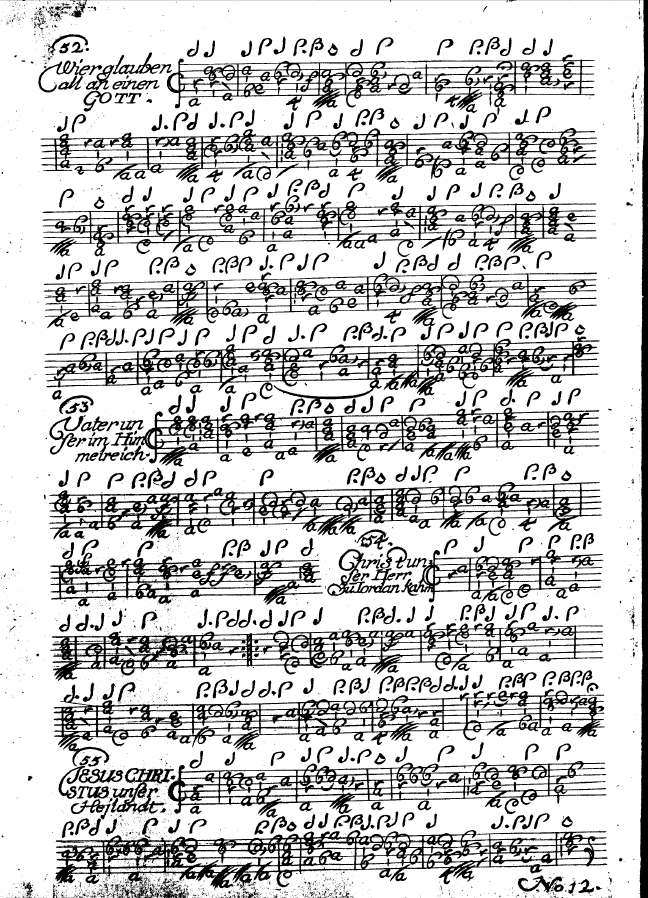 |
|
Title page and the index of song titles |
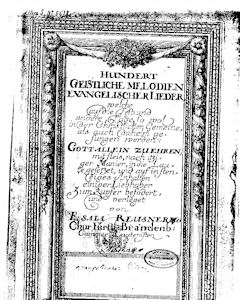
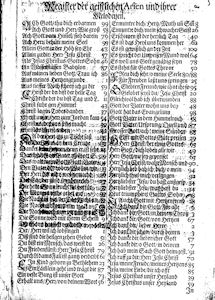
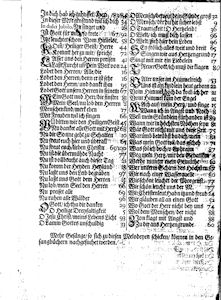 |
|
Contributed by Bernd Haegemann (June 14, 2009) |
|
Dietrich Buxtehude (c 1637-1707):
Vater unser im Himmelreich Chorale Prelude for organ, BuxWV 207 (freely composed in three verses, see score below)
Vater unser im Himmelreich Chorale Prelude for organ, BuxWV 219 (two manuals and pedal)
Corrected by mathsci (May 28, 2016) |
|
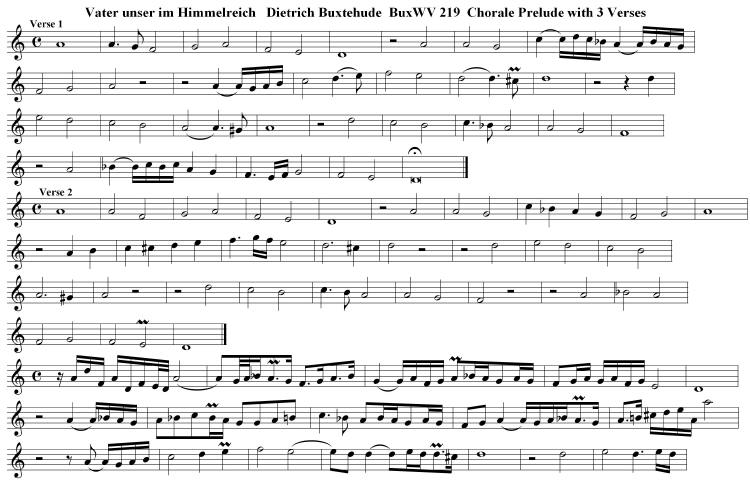
|
|

|
|
Johann Krieger, jr. (1652-1735):
Vater unser im Himmelreich, Chorale Prelude for Organ |
|
Johann Pachelbel (1653-1706):
Vater unser im Himmelreich (I), Chorale Prelude for Organ (Choräle 5), T. 5 (1693)
Vater unser im Himmelreich (II), Chorale Prelude for Organ, T. 62 |
|

|
|
Georg Böhm (1661-1733):
Vater unser im Himmelreich, chorale prelude for organ (by Georg Böhm, not JSB), BWV 760
Vater unser im Himmelreich, chorale prelude for organ (by Georg Böhm, not JSB), BWV 761
[These two chorale preludes were earlier thought to have been by J.S. Bach where they were incorrectly listed as BWV 760 and BWV 761] |
|
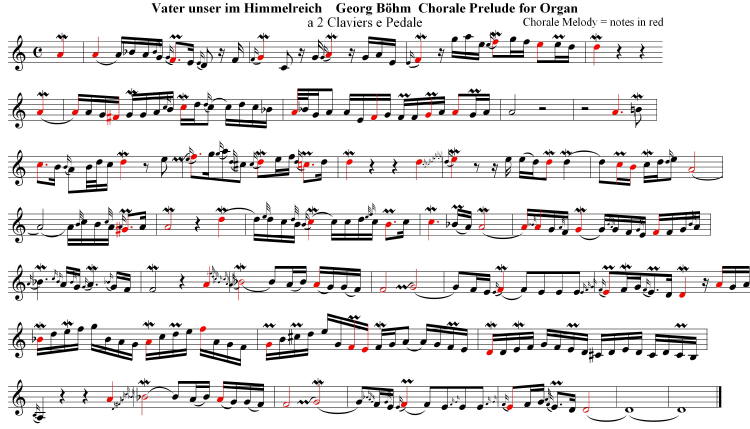
|
|
Friedrich Wilhelm Zachow (1663-1712):
Vater unser im Himmelreich, Chorale Prelude for Organ |
|
Andreas Nicolaus Vetter (1666-1734):
Vater unser im Himmelreich, Chorale Prelude for Organ |
|
Georg Philipp Telemann (1681-1767):
Vater unser im Himmelreich (Neu) (I), sacred cantata for chorus, 2 oboes, strings & continuo, TWV 1:1460 (1722)
Vater unser im Himmelreich (Neumeister) (II), sacred cantata for chorus, 2 oboes, strings & continuo, TWV 1:1461 (1722)
Chorale preludes (2), for organ in D minor (Vater unser im Himmelreich), TWV 31:1-2 (1735) |
|
Georg Friedrich Kauffmann (1679-1735):
Vater unser im Himmelreich Chorale Prelude for Organ in “Harmonische Seelenlust” (Leipzig, 1733) |
|
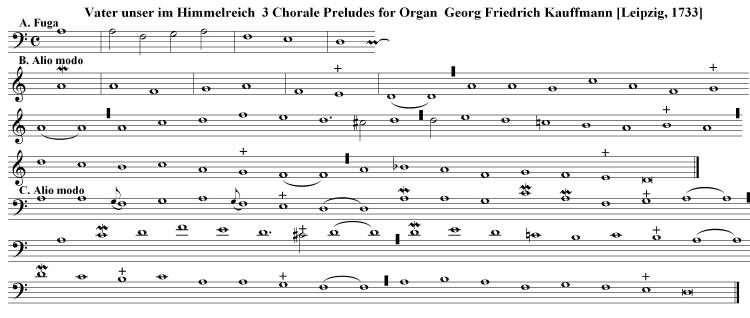
|
|
Johann Balthasar König (1691-1758):
Vater unser im Himmelreich (Rogate) Cantata for SATB, 2 Violins, Viola., Violoncello 2 Oboes., Calc., and Organ |
|
Johann Schneider (1702-1788):
Vater unser im Himmelreich, 2 Chorale Preludes for Organ |
|
Johann Ludwig Krebs (1713-1780):
Chorale for organ, Vater unser im Himmelreich
Praeambulum supra Vater unser im Himmelreich
[both works are of questionable authencity] |
|
Felix Mendelssohn-Bartholdy (1809-1847):
The chorale Vater unser im Himmelreich appears in op. 65, no. 6 in Felix Mendelssohn’s set of 6 organ sonatas composed 1844-1845.: |
|
>>Mendelssohn’s Six Sonatas op.65 (composed 1844–5), perhaps the most significant organ works from the first half of the 19th century, represent a more original assimilation of Bach’s influence; three of them (nos.1, 3 and 6), which like all ambitious 19th-century organ music were concert pieces and not intended for the church service, use chorale melodies and are therefore often described as ‘chorale sonatas’, although they are not written in the Classical sonata allegro form. Sonata no.6 indeed is in the form of the Baroque chorale partita, a form that had been sporadically cultivated throughout the late 18th and early 19th centuries. The variations (on Vater unser im Himmelreich) begin with a simple chordal setting followed by a series of cantus firmus variations culminating in a chorale fugue on the first line of the tune. The lyrical final section, a character-piece, is not related in any obvious way to the chorale. Mendelssohn’s organ sonatas inspired numerous imitations that formed important links with Reger’s chorale fantasias of 1898–1900; two of Reger’s three fantasias op.52 (on Wachet auf, ruft uns die Stimme and Halleluja! Gott zu loben) achieved a synthesis of the modern and backward-looking tendencies of the 19th century. They combine the principles of chorale variation with those of the symphonic poem, using all the technical and tonal resources of the Romantic style and the Romantic organ. But Reger, like Brahms and other late 19th-century composers, also composed in the smaller organ forms, particularly chorale preludes which, unlike the large-scale chorale fantasias, were conceived for the church service. In general, however, Reger’s organ works were intended for concert performance, so his influence on the renewal of a genuinely liturgical organ repertory in the 20th century was only indirect.<<
Robert L. Marshall & Robin A. Leaver [Grove Music Online, Oxford University Press, 2005, acc. 10/4/05
|
|
Max Reger (1873-1916):
Vater unser im Himmelreich, Chorale Prelude for organ, Op. 67/41 (1902) |
|
Wilhelm Middelschulte (1863-1943):
Canons and Fugue on the Chorale Vater unser im Himmelreich, for Organ (Leipzig, 1904)
Two Studies on the Chorale Vater unser im Himmelreich, in Verlagsgenossenschaft Organo (Zürich, 1913) |
|
Hans Friedrich Micheelsen (1902-1973):
Vater unser im Himmelreich, for organ (Organistenpraxis, Heft 2) (1952) |
|
Adolf Brunner (1901-1992):
Vater unser im Himmelreich Chorale Variations (1962) |
|
Josef-Friedrich Doppelbauer (1918-1989):
Vater unser um Himmelreich, Partita for Organ |
|
Manfred Kluge (1928-1971):
Vater unser im Himmelrich Chorale Prelude with 9 Verses for Organ (1963) |
|
Kurt Hessenberg (1908-1994):
Vater unser im Himmelreich, aria for bass solo, flute and string orchestra (1982) |
| |
|
Arrangements/Transcriptions of Bach's use of the Chorale Melody: |
|
Walter Rummel (1887-1953):
Piano transcription of Vater unser im Himmelreich BWV 760 |
|
Harriet Cohen (1895-1967):
Piano transcription of Vater unser im Himmelreich BWV 760 |
| |
|
English Hymnals using the German Chorale Melody |
|
New English Hymnal:
O quickly come, dread Judge of all (Tune: Vater Unser after Luther), No. 13 |
| |
|
Sources: NBA, vols. III/2.1 & 2.2 in particular [Bärenreiter, 1954 to present] and the BWV ("Bach Werke Verzeichnis") [Breitkopf & Härtel, 1998]
The PDF files of the Chorales were contributed by Margaret Greentree J.S. Bach Chorales
Software: Capella 2004 Software, version 5.1.
Prepared by Thomas Braatz & Aryeh Oron (October 2005, August 2006, May 2009, June 2009, August 2015, June 2016
Thanks to contributors: Jelle Kalsbeek (August 2015), mathsci (May 2016) |